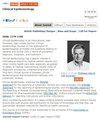Development and Validation of an Intracranial Hemorrhage Risk Score in Older Adults with Atrial Fibrillation Treated with Oral Anticoagulant
IF 3.4
2区 医学
Q1 PUBLIC, ENVIRONMENTAL & OCCUPATIONAL HEALTH
引用次数: 0
Abstract
Background: High risk of intracranial hemorrhage (ICH) is a leading reason for withholding anticoagulation in patients with atrial fibrillation (AF). We aimed to develop a claims-based ICH risk prediction model in older adults with AF initiating oral anticoagulation (OAC).Methods: We used US Medicare claims data to identify new users of OAC aged ≥ 65 years with AF in 2010– 2017. We used regularized Cox regression to select predictors of ICH. We compared our AF ICH risk score with the HAS-BLED bleed risk and Homer fall risk scores by area under the receiver operating characteristic curve (AUC) and assessed net reclassification improvement (NRI) when predicting 1-year risk of ICH.
Results: Our study cohort comprised 840,020 patients (mean [SD] age 77.5 [7.4] years and female 52.2%) split geographically into training (3963 ICH events [0.6%] in 629,804 patients) and validation (1397 ICH events [0.7%] in 210,216 patients) sets. Our AF ICH risk score, including 50 predictors, had superior AUCs of 0.653 and 0.650 in the training and validation sets than the HAS-BLED score of 0.580 and 0.567 (p< 0.001) and the Homer score of 0.624 and 0.623 (p< 0.001). In the validation set, our AF ICH risk score reclassified 57.8%, 42.5%, and 43.9% of low, intermediate, and high-risk patients, respectively, by HAS-BLED score (NRI: 15.3%, p< 0.001). Similarly, it reclassified 0.0, 44.1, and 19.4% of low, intermediate, and high-risk patients, respectively, by the Homer score (NRI: 21.9%, p< 0.001).
Conclusion: Our novel claims-based ICH risk prediction model outperformed the standard HAS-BLED score and can inform OAC prescribing decisions.
开发并验证口服抗凝剂的老年房颤患者颅内出血风险评分
背景:颅内出血(ICH)的高风险是心房颤动(AF)患者暂停抗凝治疗的主要原因。我们的目标是开发一个基于索赔的 ICH 风险预测模型,用于预测开始口服抗凝药 (OAC) 的老年房颤患者的 ICH 风险:我们使用美国医疗保险理赔数据来识别 2010 年至 2017 年期间年龄≥ 65 岁、患有房颤的 OAC 新用户。我们使用正则化 Cox 回归来选择 ICH 的预测因子。我们通过接收器操作特征曲线下面积(AUC)比较了房颤 ICH 风险评分与 HAS-BLED 出血风险和 Homer 跌倒风险评分,并评估了预测 1 年 ICH 风险时的净再分类改进(NRI):我们的研究队列包括 840,020 名患者(平均 [SD] 年龄 77.5 [7.4]岁,女性占 52.2%),按地域分为训练集(629,804 名患者中发生 3963 例 ICH 事件 [0.6%])和验证集(210,216 名患者中发生 1397 例 ICH 事件 [0.7%])。在训练集和验证集中,我们的房颤 ICH 风险评分(包括 50 个预测因子)的 AUC 分别为 0.653 和 0.650,优于 HAS-BLED 评分的 0.580 和 0.567(p< 0.001)以及 Homer 评分的 0.624 和 0.623(p< 0.001)。在验证组中,我们的房颤 ICH 风险评分按 HAS-BLED 评分分别对 57.8%、42.5% 和 43.9% 的低危、中危和高危患者进行了重新分类(NRI:15.3%,p< 0.001)。同样,根据 Homer 评分,它分别对 0.0、44.1 和 19.4% 的低危、中危和高危患者进行了重新分类(NRI:21.9%,p< 0.001):我们基于索赔的新型 ICH 风险预测模型优于标准 HAS-BLED 评分,可为 OAC 处方决策提供依据。
本文章由计算机程序翻译,如有差异,请以英文原文为准。
求助全文
约1分钟内获得全文
求助全文
来源期刊

Clinical Epidemiology
Medicine-Epidemiology
CiteScore
6.30
自引率
5.10%
发文量
169
审稿时长
16 weeks
期刊介绍:
Clinical Epidemiology is an international, peer reviewed, open access journal. Clinical Epidemiology focuses on the application of epidemiological principles and questions relating to patients and clinical care in terms of prevention, diagnosis, prognosis, and treatment.
Clinical Epidemiology welcomes papers covering these topics in form of original research and systematic reviews.
Clinical Epidemiology has a special interest in international electronic medical patient records and other routine health care data, especially as applied to safety of medical interventions, clinical utility of diagnostic procedures, understanding short- and long-term clinical course of diseases, clinical epidemiological and biostatistical methods, and systematic reviews.
When considering submission of a paper utilizing publicly-available data, authors should ensure that such studies add significantly to the body of knowledge and that they use appropriate validated methods for identifying health outcomes.
The journal has launched special series describing existing data sources for clinical epidemiology, international health care systems and validation studies of algorithms based on databases and registries.
 求助内容:
求助内容: 应助结果提醒方式:
应助结果提醒方式:


